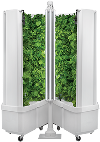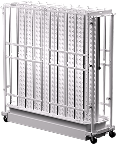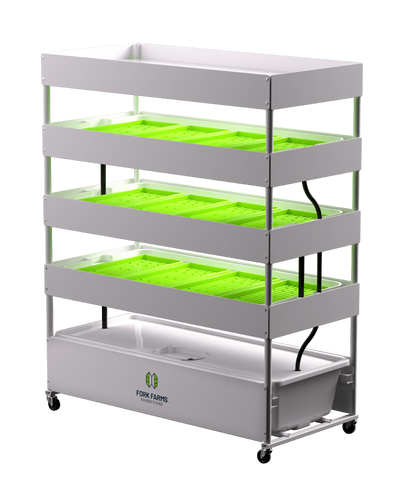How Much Does it Cost to Start a Hydroponic Farm: A Comprehensive Guide
Discover the potential costs associated with setting up a hydroponic system. Explore the various factors that influence the overall expenses.
Understanding the Basics of Hydroponic Farms
Hydroponic farms us a method of growing plants without soil. Plants are grown in a nutrient-rich water solution that provides all the necessary minerals and elements for their growth. This method allows for a more controlled environment, resulting in faster growth and higher yields.
There are several types of hydroponic systems, including nutrient film technique (NFT), deep water culture (DWC), aeroponics, and more. Each system has its advantages and considerations, but they all share the same basic principle of providing plants with the nutrients they need directly through the water solution.
Hydroponic systems also require careful monitoring of factors such as pH levels, nutrient concentrations, and water quality. By understanding the basics of hydroponic systems, you can better assess the costs involved in setting up and maintaining such a system.
Factors Affecting the Cost of a Hydroponic Farm
The cost of setting up a hydroponic farm can vary depending on several factors. These factors include the type of hydroponic system, the size of the system, the quantity of food production desired, necessary infrastructure improvements, and consumable expenses such as seeds, grow medium, nutrients, and pH testing kits.
- Type of Hydroponic System: Different types of hydroponic systems have different costs associated with them.
- Size of the Hydroponic System: The size of the system directly impacts the overall cost. Larger systems typically require more materials, equipment, and space, resulting in higher expenses.
- Quantity of Food Production: The amount of food you want to produce will determine the size and capacity of your hydroponic system. If you aim to produce a higher quantity of food, you may need a larger system with more advanced features, which can increase the initial investment costs.
- Infrastructure Improvements: Setting up a hydroponic system may require certain infrastructure improvements, such as upgrading electrical, ventilation, and water filtration systems such as an RO. These improvements can add to the initial setup costs.
- Consumables and Operational Costs: In addition to the initial setup costs, there are ongoing consumable expenses to consider. This includes purchasing seeds, grow medium, nutrients, pH testing kits, and other operational costs. These expenses can vary depending on the size of your system and the type of plants you are growing.
Considering these factors will help you estimate the overall cost of starting a hydroponic farm and determine a budget that suits your needs and goals.
Type of Hydroponic System
The type of hydroponic system you choose will have an impact on the cost of setting up your farm. As mentioned earlier, different systems have different complexities and requirements, which can affect the overall expenses.
There are several types of hydroponic and water culture systems available on the market, each with its advantages and applications. Here are some common types that you can compare in terms of application and expense of operation.
Deep Water Culture (DWC): In DWC systems, plants are suspended in nutrient-rich water with their roots submerged. Air stones provide oxygen to the roots. This system is simple but effective.
Nutrient Film Technique (NFT): NFT systems involve a thin film of nutrient-rich water flowing over the roots. The roots are exposed to both water and air, promoting oxygen uptake. This system is popular for growing smaller plants like lettuce.
Aeroponics: Aeroponic hydroponic systems mist the roots with a nutrient solution, allowing for high oxygen levels. This method can be more efficient in nutrient absorption, making it suitable for faster plant growth.
Drip System: Drip systems deliver nutrient solutions directly to the base of each plant through a network of tubing and emitters. This method is versatile and widely used in various setups.
Wicking System: Wicking hydroponic systems use a wick to draw nutrient solution from a reservoir to the growing medium, ensuring a constant supply of water and nutrients to the plants.
Ebb and Flow (Flood and Drain): In this system, nutrient solution periodically floods the growing medium and then drains away. This cyclical flooding provides both nutrients and oxygen to the plants.
Vertical Hydroponic Farming Systems: These systems are designed to maximize vertical space by stacking layers of plants. They can incorporate various hydroponic techniques, such as NFT or aeroponics.
Aquaponics: Aquaponic hydroponic systems combine hydroponics with aquaculture. Fish waste provides nutrients for the plants, and the plants help filter and purify the water for the fish.
These are just a few examples, and there are many variations and hybrid systems on the market. The choice of hydroponic system depends on factors such as the type of plants you're growing, available space, budget, and personal preferences.
Ultimately, the type of hydroponic system you choose should align with your goals and budget.
Size of the Hydroponic Farm Operation
The size of your hydroponic farm operation directly impacts the overall cost. Larger hydroponic farms require more resources, equipment, and space, which can increase expenses.
When determining the size of your system, consider factors such as the available space, your production goals, and your budget. It's important to find a balance between the size of the system and your ability to efficiently manage and maintain it. Aligning your system's size with your production targets is essential.
Efficient management and maintenance are key aspects of a successful hydroponic farm, and they may become more complex with larger operations. Consider your ability to effectively oversee the system, addressing functional areas such as nutrient management, water quality, and crop rotation. Investing in staff training and implementing management protocols becomes increasingly important with a larger operation.
Starting with a smaller, module hydroponic farm may be more cost-effective initially, allowing you to gain experience and expand as you become more comfortable with hydroponic farming.
Quantity of Food Production Desired From Your Hydroponic System
The quantity of food you want to produce will influence the size and capacity of your hydroponic system. If you aim to produce a larger quantity of food, you will need a system with a larger growing capacity and additional features to aid in the management of the system.
A larger hydroponic farming setup will require additional materials, equipment, and resources, which could increase the overall cost depending on the system. It's important to carefully assess your production goals and balance them with your budget. Starting with a smaller system and gradually scaling up as demand increases can be a more cost-effective approach.
Additionally, consider the demand for the specific crops you plan to grow. Ensuring there is a demand for your produce will help justify the investment in a hydroponic system that will produce higher yields.
Infrastructure Improvements May Be Needed To Accommodate the Hydroponic Farm
Setting up a hydroponic system may require certain infrastructure improvements to create an optimal growing environment. These improvements can add to the overall cost of starting a hydroponic farm.
Some common infrastructure improvements include electrical upgrades, ventilation, and water filtration systems. These improvements ensure that your plants receive adequate light, air, and water, which are essential for their growth.
The cost of these improvements will depend on the size of your system and the specific requirements of your plants. It's important to factor in these costs when estimating the overall expenses of setting up a hydroponic farm.
Consumables and Operational Costs To Consider
In addition to the initial setup costs, there are ongoing consumable expenses associated with operating a hydroponic farm. These expenses include purchasing seeds, grow medium, nutrients, pH testing kits, and other operational costs.
The cost of consumables will vary depending on the size of your system and the type of plants you are growing. Different plants have different nutrient requirements, and certain crops may require specialized grow mediums or specific pH levels.
It's important to budget for these ongoing expenses to ensure the continuous operation of your hydroponic farm. Regularly monitoring and adjusting the nutrient levels and pH of your system will help optimize plant growth and maximize yields.
Consider researching the specific requirements of the crops you plan to grow and estimating the associated consumable costs. This will help you plan and budget accordingly.
Summary of Considerations That Affect The Cost Of a Hydroponic Farm System
Starting a hydroponic farm involves various costs that need to be considered. The overall expenses can vary depending on factors such as the type and size of the hydroponic system, the quantity of food production desired, necessary infrastructure improvements, and consumable expenses.
At Fork Farms, we work with you from the very beginning to help understand what you’d like to achieve with your hydroponic farm program. We offer several hydroponic solutions that are module, scalable and have lower operating costs. All of our hydroponic farm systems come with everything you need to start growing efficiently.
For example, the Flex Farm is the most efficient, scalable, and transformative indoor, vertical hydroponic technology on the planet. By carefully controlling everything plants need to thrive, each Flex Farm can grow more than 394 pounds of produce annually. They’re portable and only require a standard electrical outlet and less than 10 square feet of space.
The Flex Farm comes with everything you need to grow which includes: 288 plant spaces, a fully self-contained water system, an energy-efficient LED light tower, a submersible pump, a Grower Toolkit, and a Starter Supplies Box. The purchase of a Flex Farm includes Free Access to Farmative and expert growing support from our Partner Support Team.
Another example is the Flex Acre and Acre products from Fork Farms. The Acre products are plug-and-play indoor farm solutions at scale. This large-scale hydroponic farming solution brings the mechanical, electrical, and plumbing complexities of a large farm installation into a simple, prefabricated solution.
By understanding the basics of hydroponic systems and assessing the factors outlined above, you can estimate the average cost of setting up a hydroponic farm that aligns with your goals and budget. It's important to carefully plan and budget for both the initial setup costs and the ongoing expenses to ensure the success and sustainability of your hydroponic farm.
Remember, starting a hydroponic farm requires research, preparation, and ongoing commitment. With proper planning and attention to detail, you can create a thriving hydroponic farm that provides you with fresh, nutrient-rich produce.























